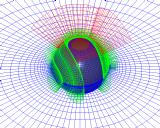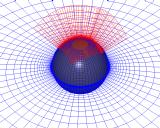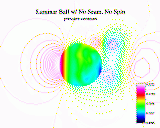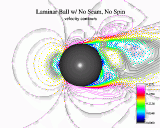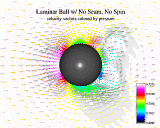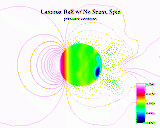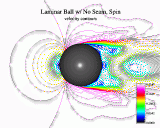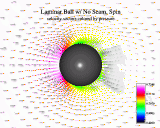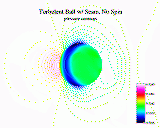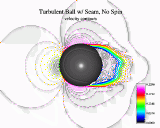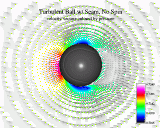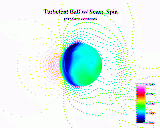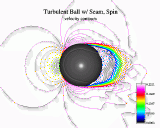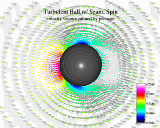June 2004 Article Tennis Server
|

 |
Why A Flaming Tennis Ball Doesn't Fly With A Tennis Aerodynamicist
I had hoped to write an article like this for the April edition. While the subject is rigorous, I think that there is a bit of humor in it - and appropriate for an "April Fool's" column. Getting to the point: you know the little logo of a tennis ball with a trail of flames used for the US Open? From the first time I saw it, it bothered me. I guess as an aerodynamicist that has a practice in sports engineering I knew the flow just wasn't right. Flames would never curve around the back of the ball that way. So - how sure am I of that? I guess I could try and prove it to myself. However, wanting to try some simulations out "safely" without burning myself I thought that I could build on a past computer simulation which some colleagues and I conducted a few years ago. Here's what we did. Computers are used extensively throughout sport science, engineering and technology to aid in the design and analysis of sports equipment and athletic performance. In aerodynamics, scientists have developed mathematical models which emulate the physics of fluids. These mathematical fluid models are programmed into software applications which can be used on the computer. An engineer can take an object, like an airplane or ball, and use the fluid model to analyze how this object would perform in "flight." It's like having a virtual wind tunnel. The process is called "Computational Fluid Dynamics" or "CFD" for short. In this section we will show you the steps we take in doing a CFD simulation, by performing a simulation of the tennis ball.
Gathering the Correct Information
The tennis ball is roughly a 2.5-inch sphere. It has a continuous hourglass shaped seam, and a felt-like fuzz. The fuzz of the tennis-ball is a very porous and non-uniform surface. This makes the fuzz surface very difficult to simulate with a CFD model. For this reason we chose to leave out the fuzz (this time), and model the tennis ball as if it had a smooth surface. The seam of the tennis ball, however, can be modeled easily. We left this feature of the tennis ball in our simulation. The average professional tennis player serves the ball at 120mph, and a low spin of 1000rpm (revolutions per minute) was used.
Determining What Cases to Run
One thing that is often done in aeronautics, and science in general, is comparing and contrasting. Scientists compare and contrast in their experiments in order to see how much little changes effect their results. Here we set up four different cases, so that we can compare and contrast between them. The first case is a smooth ball with no seam and no spin. The second case is a smooth ball with no seam, spinning at 1000rpm. The third case is a ball with a seam but no spin. The fourth case is a ball with both a seam and spin. By comparing these four cases, we hope to see how much spin and the seam of the tennis ball effect its flight.
Creating a Computer Model of the Flying Body: Grid Generation:
Getting the Results and Analyzing Them Once the grids are done and the cases to study determined, we can run our CFD simulation! CFD simulations can take a long time to run. Depending on the problem, running simulations can take an hour, a few weeks or even longer! The tennis ball simulations we ran took about a half a day. Results:
Most of the results you'll see are in the form of colorful graphs. The two types of graphs that are shown are contour graphs and vector graphs. These graphs are used to show the pressure and the velocity of the flow. Pressure plots help to show what the forces are that are acting on the ball, and velocity plots show how the flow is moving around the ball. You'll notice that the results for the tennis balls are displayed under two headings "Laminar" and "Turbulent". Laminar and turbulent are terms which refer to the boundary layer of the fluid flow, which in simple terms is flow very close to the surface of a solid body. Laminar flow is boundary layer flow that is "orderly." Turbulent flow is boundary layer flow which is "random" and "chaotic." Laminar and turbulent flow are mathematically modeled differently in the computer simulation software, so sometimes we have to decide which type of flow will be dominant in our simulation and use the appropriate model. The tennis ball is special because at the speed it travels, it lies around the border of being both predominantly laminar and predominately turbulent. Consequently, for some of the simulations we performed we used both a laminar and a turbulent model.
What is a Contour?
Contour maps are not only used to display elevation. Watch a weather forecast on television. Sometimes the weather person will show a colored map with temperatures over a large region. Regions colored red are where the temperature is hot. Regions which are yellow or green are where the temperature is moderate. Regions colored blue are where temperatures are cold. This colored weather map is also a kind of contoured map. Here the contours represent temperature instead of elevation.
Contour maps are used a lot in CFD for displaying results. Take a look at the following samples of CFD results we calculated for a tennis ball.
The picture on the left shows contours of pressure. The picture on the right shows contours of velocity. Just as the colored regions on the temperature weather map represented values of temperature, the color of the contour lines in the above pictures represent values pressure or velocity. Red stands for high pressures or high velocities. Blue stands for low pressures or low velocities.
Vectors show both magnitude (how big or strong something is) and direction. They are usually represented by an arrow. Vectors are kind of like the wind vanes you might see on a barn. The wind vane will point in the direction which the wind is blowing. However wind vanes do not tell you how strong the wind is blowing. Vectors do. The length of a vector depends upon how strong the flow is. Long vectors mean the flow is strong and fast. Short vectors mean the flow is weak and slow. Vectors are often used to show how fluid flows around an object, like in the picture below.
Take a close look at the vectors in the picture (remember that you can click on it to see a larger version). Notice how in front of the ball the vectors are directed smoothly along the surface of the ball. Behind the ball the vectors start to "leave" the surface and become jumbled. Sometimes the vectors make "swirling" patterns. When the flow around a body no longer follows the body's surface, it is called separation, because the flow "separates" from the surface. In all the tennis ball results we show, there is separation. When you look at the results, notice where and how the flow separates from the ball. Almost all our tennis ball results will show different separation. Differences in where and how flow separates from an object effect the object's "flight." Another thing to note when looking at the vector plot are the vectors' length. As we get closer to the tennis ball, notice how the vectors become shorter and shorter. This means that the flow near the tennis ball slows down. If you were able to take a close-up view of the flow at the tennis ball surface, you'd see that the vector's length would shrink to nothing. At the surface the flow stops, because the surface "grabs" on to the fluid or air that touches it. I have some work ahead of me but I've wanted to try this simulation with felt on the ball and some flames. So the plan is to try this and post the results in time for this year's US Open. Until Next Month ... Jani
This column is copyrighted by Jani Macari Pallis, Ph.D., all rights
reserved.
Dr. Jani Macari Pallis is the founder and CEO of Cislunar Aerospace,
Inc., an engineering and research firm in San Francisco. In addition
to her engineering practice, she has led two collaborations between
NASA and Cislunar, creating educational materials on the aerodynamics
of sports for pre-college students and educators. As the head of
NASA's "Aerodynamics in Sports" project, she has led a team of
researchers investigating the aerodynamics, physics and biomechanics
of tennis. The group has conducted high speed video data capture at
the US Open and research of ball/court interaction, footwork, serve
speeds, trajectories and ball aerodynamics. Pallis received a BS and
MS from the Georgia Institute of Technology, an MS in mechanical
engineering from the University of California, Berkeley and a Ph.D.
in mechanical and aeronautical engineering from the University of
California, Davis. She is a member of the Executive Committee of The
International Sports Engineering Association.
Questions and comments about these columns can be directed to Jani by
using this form.
|



October 2022 Tennis Anyone: Patterns in Doubles by John Mills. September 2022 Tennis Anyone: Short Court by John Mills. |
 You will join 13,000 other subscribers in receiving news of updates to the Tennis Server along with monthly tennis tips from tennis pro Tom Veneziano.
You will join 13,000 other subscribers in receiving news of updates to the Tennis Server along with monthly tennis tips from tennis pro Tom Veneziano. 
